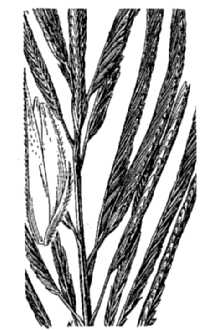Sporobolus cynosuroides (L.) P.M. Peterson & Saarela
Scientific Name: Sporobolus cynosuroides (L.) P.M. Peterson & Saarela

| General Information | |
|---|---|
| Usda Symbol | SPCY4 |
| Group | Monocot |
| Life Cycle | Perennial |
| Growth Habits | Graminoid |
| Native Locations | SPCY4 |
Plant Guide
Use a soil moisture meter to monitor the soil moisture where Sporobolus cynosuroides (L.) P.M. Peterson & Saarela is planted.
Fact Sheet
Alternate Names
Salt reedgrass
Uses
Cattle graze big cordgrass. Ducks and geese eat the tender shoots that grow after marshes are burned in early fall.
Status
Please consult the PLANTS Web site and your State Department of Natural Resources for this plant’s current status, such as, state noxious status and wetland indicator values.
Description
Grass Family (Poaceae). Big cordgrass is a warm-season, robust, rhizomatous perennial. The height ranges from 3 to 10 feet. The leaf blade is flat and 1/2 to 1 inch wide; often 18 to 24 inches long; rough and sharp margin. The leaf sheath is rounded. The ligule has short membrane and densely hairy. The stem is thick, round and often 3/4 inch in diameter at base. The seedhead has 20 to 40 spikes, each about 3 inches long, and spikelets about 1/2 inch long growing on one side of rachis with the seedhead growing 12 to 18 inches long.
Management
For best production and plant vigor, graze big cordgrass during fall and winter and defer grazing during summer.
Establishment
Major growth is from late March through September or October, Seedheads form during fall, The base of the plant remains green through the winter, It reproduces from robust rhizomes, which form dense colonies, This plant is primarily adapted to mineral soils in salt marshes, It tolerates moderate salinity and water levels that fluctuate from 4 inches below soil surface to 2 inches above, Use soil moisture sensors to measure the soil moisture of Sporobolus cynosuroides (L.) P.M. Peterson & Saarela., It is closely associated with marsh-hay cordgrass (Spartina patens) and common reed (Phragmites australis), Cultivars, Improved and Selected Materials (and area of origin) Please contact your local NRCS Field Office,
Plant Traits
Growth Requirements
| Temperature, Minimum (°F) | -3 |
|---|---|
| Adapted to Coarse Textured Soils | Yes |
| Adapted to Fine Textured Soils | Yes |
| Adapted to Medium Textured Soils | Yes |
| Anaerobic Tolerance | High |
| CaCO3 Tolerance | Medium |
| Cold Stratification Required | No |
| Drought Tolerance | None |
| Fertility Requirement | Medium |
| Fire Tolerance | High |
| Frost Free Days, Minimum | 210 |
| Hedge Tolerance | None |
| Moisture Use | High |
| pH, Maximum | 7.5 |
| pH, Minimum | 5.8 |
| Planting Density per Acre, Maxim | 11000 |
| Planting Density per Acre, Minim | 2700 |
| Precipitation, Maximum | 60 |
| Precipitation, Minimum | 40 |
| Root Depth, Minimum (inches) | 20 |
| Salinity Tolerance | High |
| Shade Tolerance | Intolerant |
Morphology/Physiology
| After Harvest Regrowth Rate | Slow |
|---|---|
| Toxicity | None |
| Resprout Ability | No |
| Shape and Orientation | Erect |
| Active Growth Period | Spring and Summer |
| Bloat | None |
| C:N Ratio | Medium |
| Coppice Potential | No |
| Fall Conspicuous | No |
| Fire Resistant | No |
| Flower Color | Yellow |
| Flower Conspicuous | No |
| Foliage Color | Green |
| Foliage Porosity Summer | Dense |
| Foliage Porosity Winter | Moderate |
| Fruit/Seed Color | Brown |
| Nitrogen Fixation | None |
| Low Growing Grass | Yes |
| Lifespan | Long |
| Leaf Retention | No |
| Known Allelopath | No |
| Height, Mature (feet) | 8.0 |
| Growth Rate | Moderate |
| Growth Form | Rhizomatous |
| Fruit/Seed Conspicuous | No |
| Foliage Texture | Coarse |
Reproduction
| Vegetative Spread Rate | Rapid |
|---|---|
| Small Grain | No |
| Seedling Vigor | Low |
| Seed Spread Rate | Slow |
| Fruit/Seed Period End | Fall |
| Propagated by Tubers | No |
| Propagated by Sprigs | Yes |
| Propagated by Sod | No |
| Propagated by Seed | No |
| Propagated by Cuttings | No |
| Propagated by Container | No |
| Propagated by Bulb | No |
| Propagated by Bare Root | Yes |
| Fruit/Seed Persistence | No |
| Fruit/Seed Period Begin | Summer |
| Fruit/Seed Abundance | Low |
| Commercial Availability | Routinely Available |
| Bloom Period | Spring |
| Propagated by Corm | No |
Suitability/Use
| Veneer Product | No |
|---|---|
| Pulpwood Product | No |
| Protein Potential | Low |
| Post Product | No |
| Palatable Human | No |
| Palatable Graze Animal | Low |
| Palatable Browse Animal | Low |
| Nursery Stock Product | No |
| Naval Store Product | No |
| Lumber Product | No |
| Fodder Product | No |
| Christmas Tree Product | No |
| Berry/Nut/Seed Product | No |

